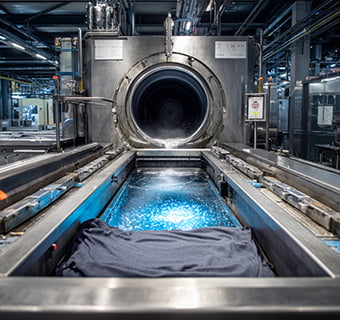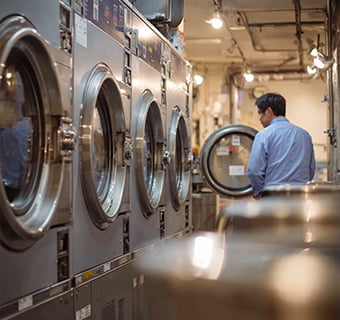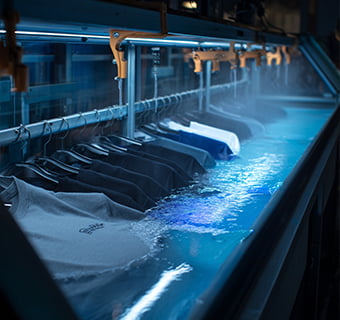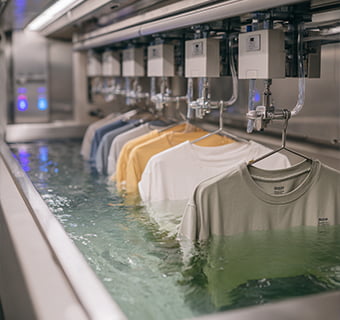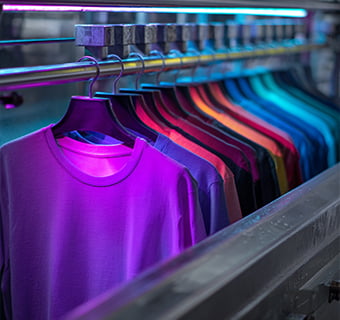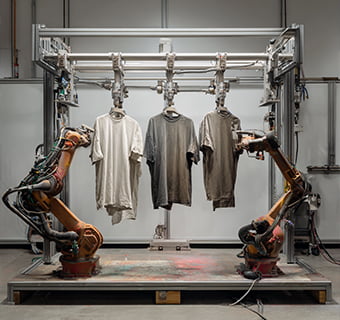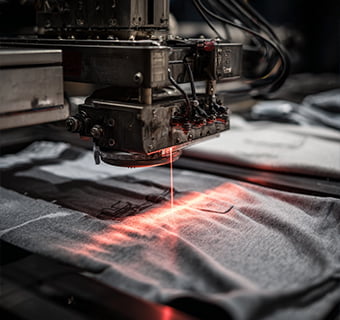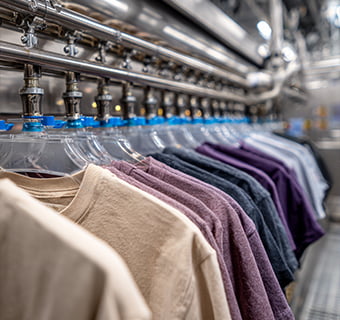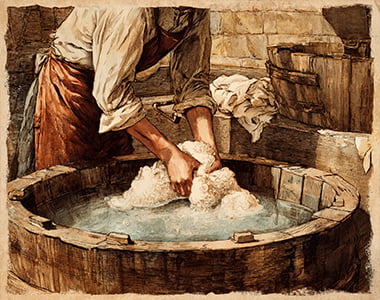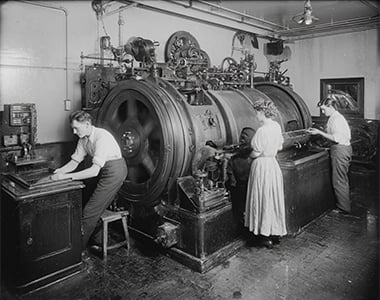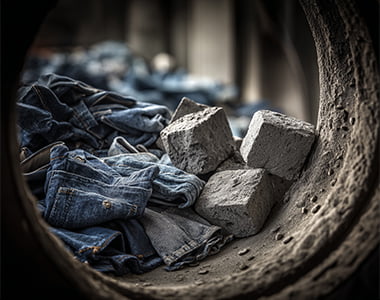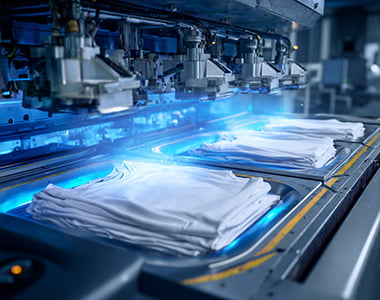Vintage Tops Manufacturer | Perfecting Washed Craftsmanship Since 2009
Professional Explanation of Vintage Wash Techniques
From Basic to Advanced,
a Comprehensive Analysis of the Essence and Innovation in Vintage Wash T-Shirts,
Sweatshirts, Baseball Jackets, and Padded Jackets

Garment Washing Factory
We formally invested in
a self-built washing plant in 2025, which is equipped with advanced
equipments to support a variety of processes such as enzyme washing,
sandblasting, cat whisker, stone washing and so on. The self-built
washing line makes us more efficient and controllable from production to
shipment, guarantees the quality of garments, shortens the delivery
time, and supports customers' rapid sampling and bulk orders. Welcome to
visit our factory or come to us for customization!
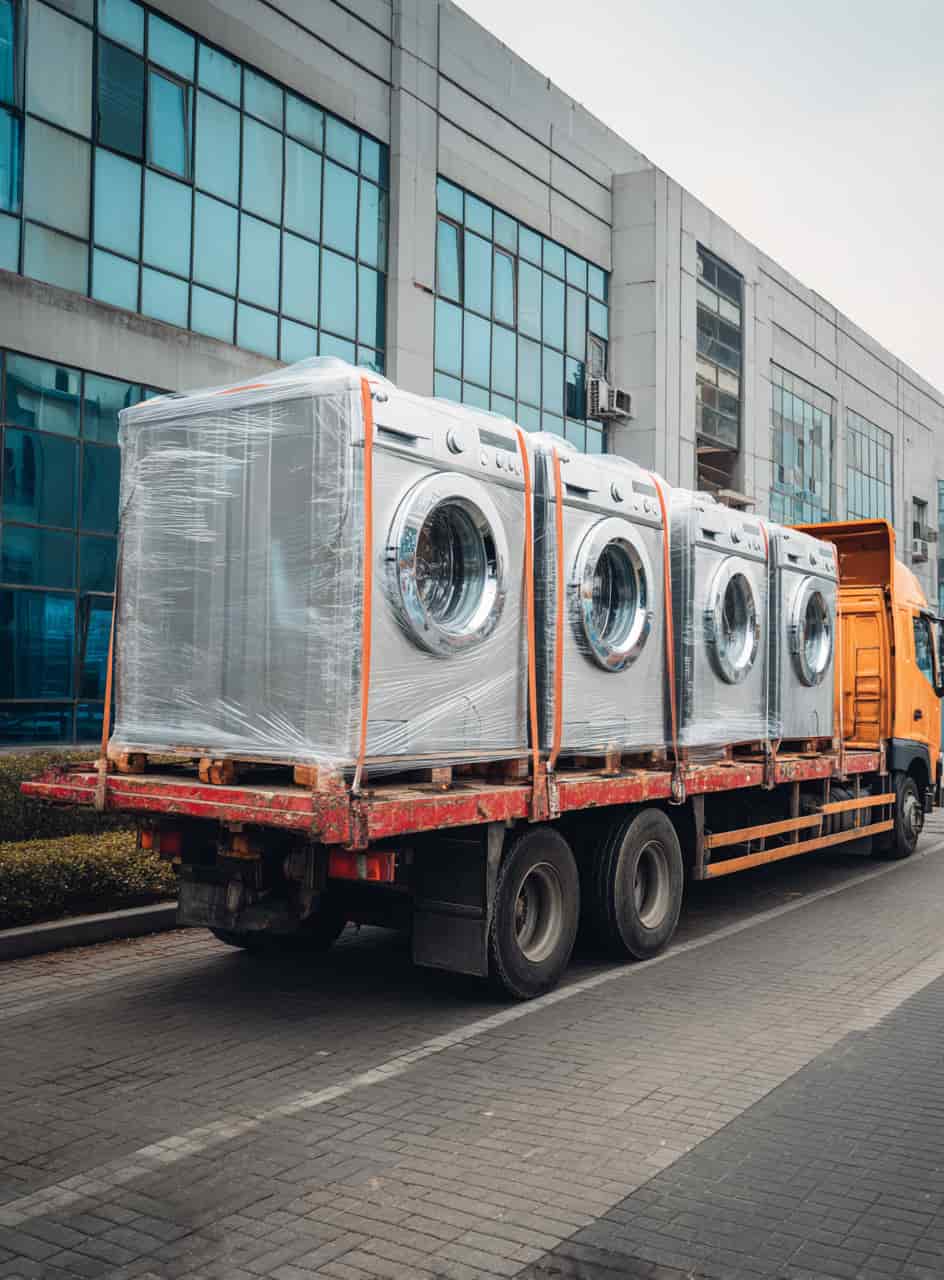
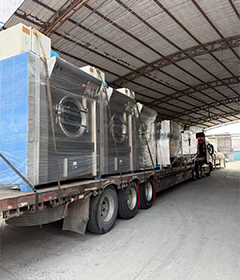
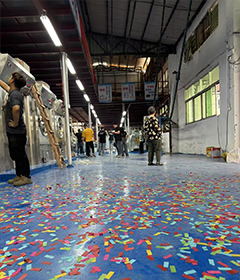
1. Introduce
As a timeless and
iconic category, vintage-washed T-shirts, sweatshirts, baseball jackets,
and padded jackets owe much of their unique appeal to the washing process.
This process not only imparts a distinctive look but also enhances the
comfort and feel of each garment. For factories specializing in high-quality
vintage-washed apparel, mastering the washing process is key to building
long-term relationships with international brands, designers, and growing
businesses. In this article, we will explore every facet of the vintage
washing process, from its origins, the essential techniques, process details,
sustainable solutions, to emerging trends. Whether you're a professional in
the industry, a designer, a brand owner, or a hobbyist interested in vintage-wash
apparel, this guide will provide valuable insights and knowledge.
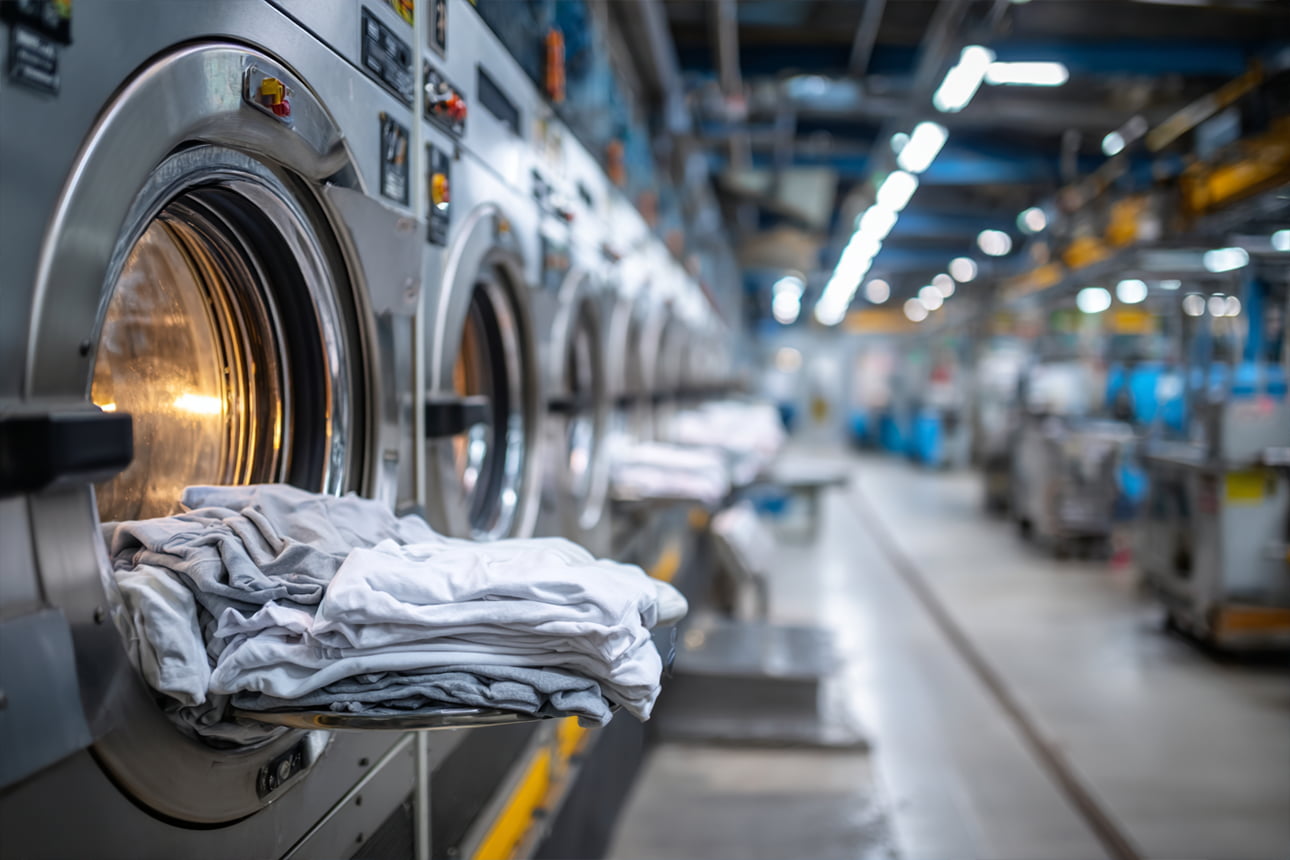
2. A Brief History Of Washing Technology
Washing technology has
evolved from early manual washing to industrialized mechanical processes, and
now to modern automated and eco-friendly techniques. Today, advanced methods
such as laser treatments, stone washing, and sustainable processes not only
create unique looks for garments but also enhance comfort while reducing
environmental impact.
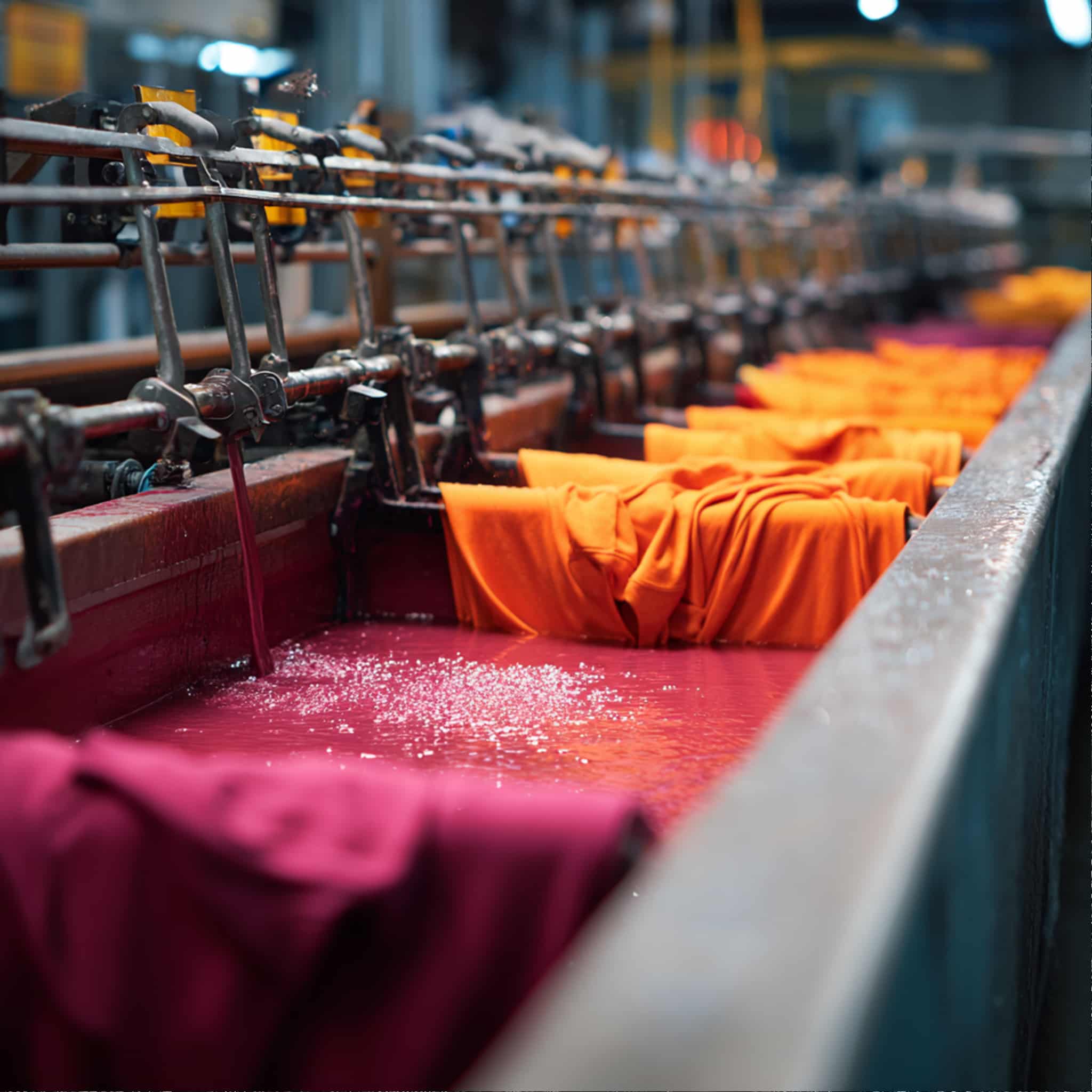
3. Basic Knowledge of Dyeing for T-shirts and Sweatshirts
Main Types and
Fabric Characteristics
-
Weight Classification
Fabrics used in vintage-wash T-shirts and sweatshirts range from lightweight (5-9 ounces) to medium weight (10-14 ounces). Different weights provide varying softness and washing effects.
- Weaving Method
Common weaves for T-shirts and sweatshirts include single jersey (smooth and soft), French terry (looped texture), and hoodie weaves (durability for vintage wash effects). - Raw Material Composition
Fabrics can range from 100% cotton to blends like cotton-polyester and cotton-spandex, each influencing the feel and wash outcome differently. - Dyeing Method
Methods such as garment-dyeing and yarn-dyeing create different fading effects and color depth, impacting the overall vintage look after washing.
3.2 Dyeing Process and Principlese
The dyeing process
for vintage-wash T-shirts and sweatshirts typically involves garment-dyeing
or yarn-dyeing. Garment-dyeing provides a uniform base color that fades
uniformly during washing, while yarn-dyeing adds depth and a more complex
color pattern. Understanding these dyeing principles helps predict the visual
effects and fading patterns of the fabric after the washing process.
1. Pre-Wash Treatment
Before dyeing, T-shirts and sweatshirts
undergo a pre-wash treatment to remove any impurities, stabilize the fabric,
and prepare it for the dyeing process. This step ensures that the fabric
absorbs the dye uniformly, resulting in a
consistent color finish.
4. Repeating
To achieve darker and more pronounced color
effects, the dyeing process is often repeated. Fabrics may go through
multiple cycles of dyeing and fixation to reach the desired shade and visual
complexity. Methods like continuous dyeing and garment-dyeing can help to achieve
different fading effects and vintage looks.
2. Dyeing
The fabric is immersed in a dye solution containing
selected dyes (such as reactive or garment dyes). The dye molecules penetrate
the fabric fibers, giving the T-shirts and sweatshirts their base color.
Different dyeing techniques, such as garment-dyeing or yarn-dyeing, are used
to achieve the desired visual effect.
3. Fixation
Once the fabric is dyed, it undergoes a fixation
process where the dye molecules are locked into the fibers, ensuring
long-lasting color. This process is often carried out in a high-temperature
setting, allowing the dye to set deeply within the fabric for a durable finish.
4. Detailed Explanation of Basic Washing Process
The basic washing process
enhances fabric texture, making it more comfortable and improving the overall
appearance. It serves as the foundation for advanced techniques.
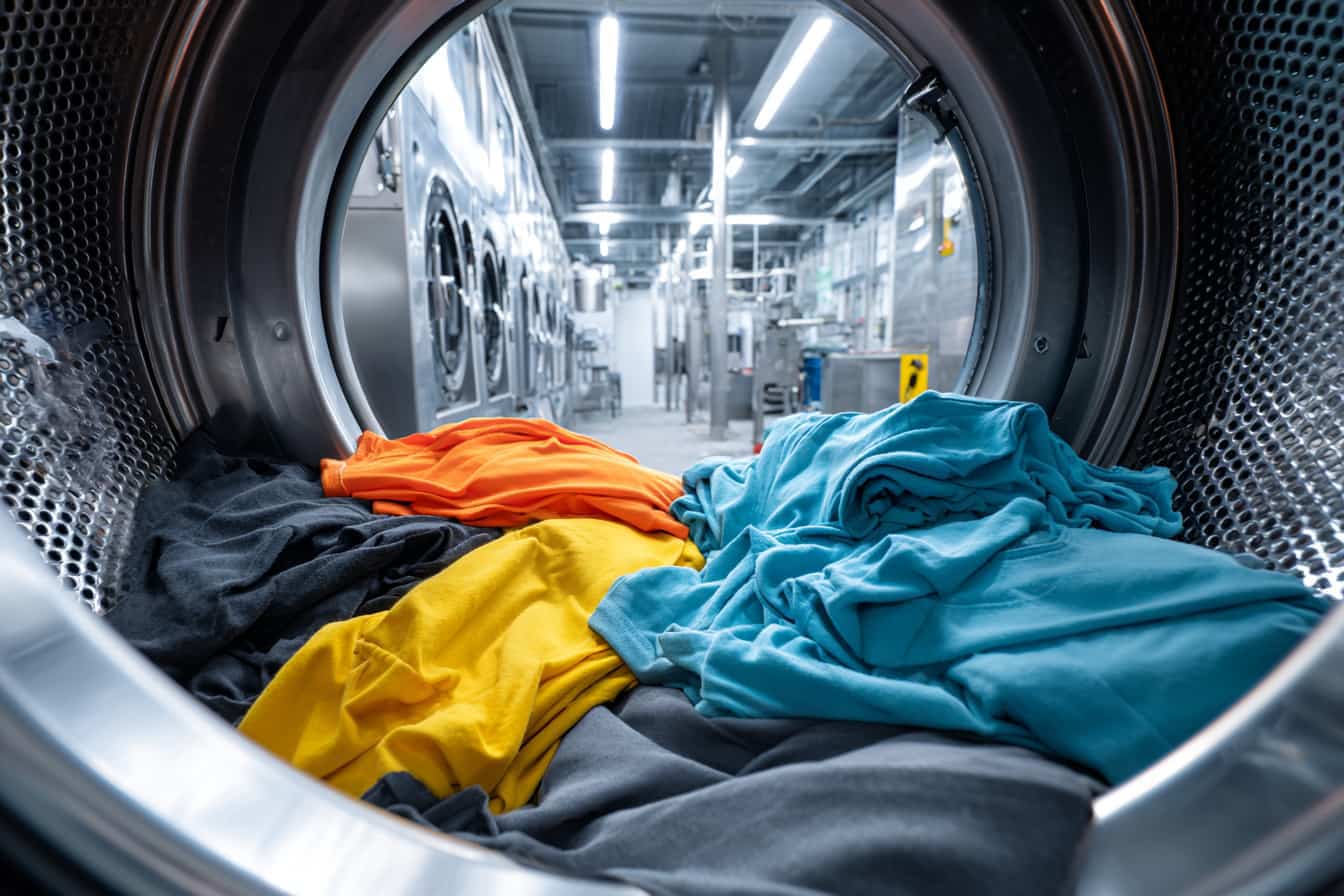
4.1 Garment Wash:
Soften and remove impurities by washing at 60–90°C for 5-30 minutes, with detergent and softener. Ideal for dark fabrics or as pre-treatment.
4.2 Stone Wash:
Create natural fading using pumice stones for 30–90 minutes with low water levels. Perfect for achieving a retro, worn look on fabrics.
4.3 Enzyme Wash:
Use enzymes at 40–60°C for 30–60 minutes to soften fabric and create a smooth, faded effect. Ideal for high-end, comfortable T-shirts and sweatshirts.
4.4 Sand Wash:
Enhance fabric softness with sand powder at 30–60°C for 30–60 minutes, creating a frosty, vintage effect. Suitable for casual and everyday wear.
4.5 Bleach Wash:
Apply chlorine or oxygen bleach for 7–10 minutes to achieve significant fading effects. Ideal for creating designs that highlight color contrast.
5. Pro Wash Tech
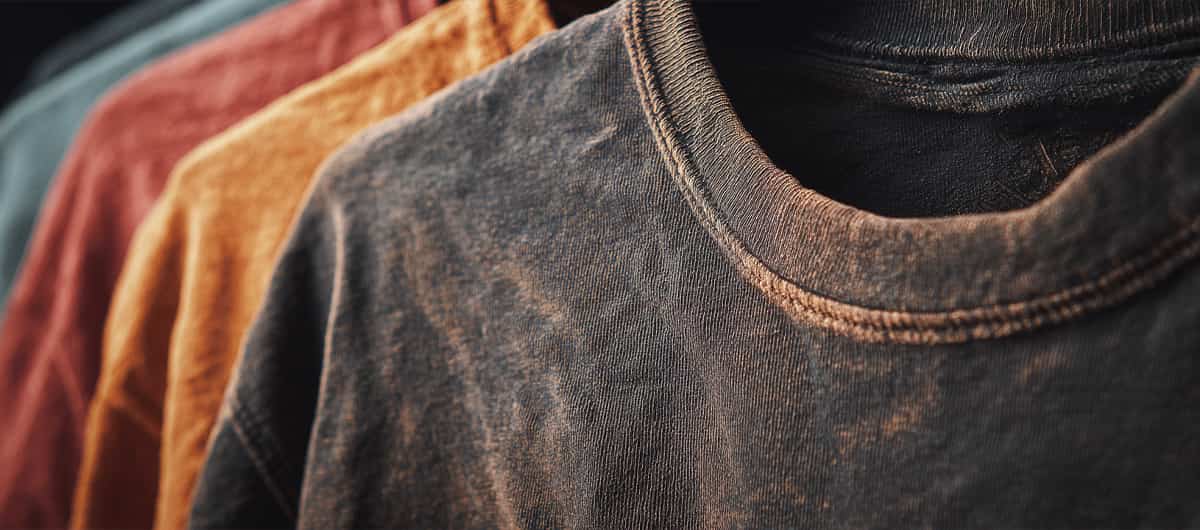

- 5.1 Whisker Effect:
Simulates natural wear and color fading. Common techniques
include:
·Ordinary whiskers:Hand-rubbed, low cost,
suitable for fast fashion.
·3D whiskers:Light
and dark layering for high-end brands, requiring advanced
techniques.
·Hand-sewn whiskers:Natural texture created by
seams or hot pressing, with a unique, three-dimensional look.
·Laser whiskers:Precise grinding using lasers,
efficient and eco-friendly, ideal for large-scale production, though
less natural in appearance.
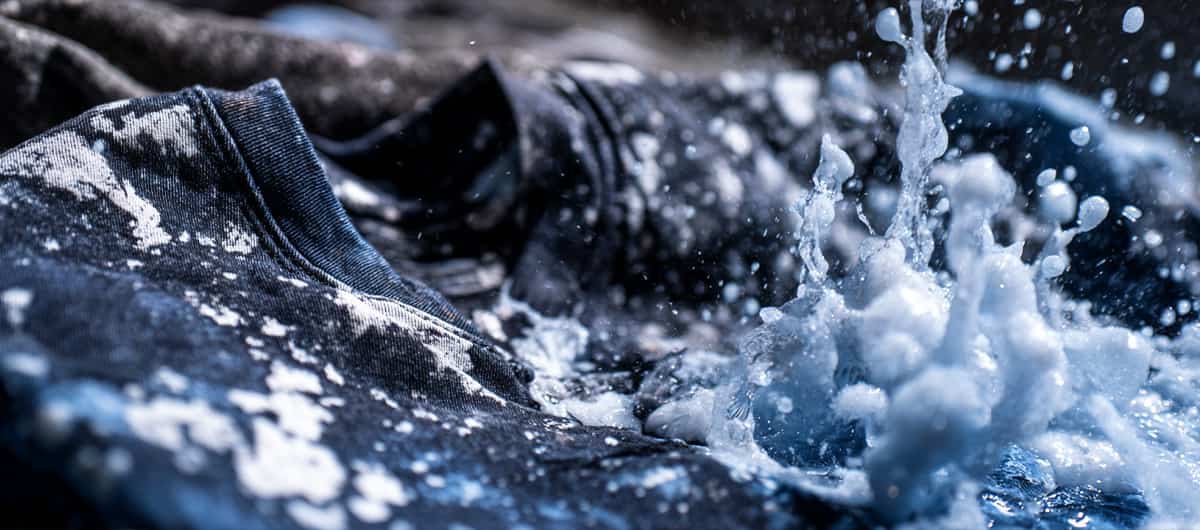

- 5.2 Snow Wash
Pumice stones soaked in potassium permanganate are used to grind denim, creating a random "snowflake" effect. The process is finished with oxalic acid to neutralize chemicals. Popular for vintage-inspired looks, offering strong contrast and artistic flair.
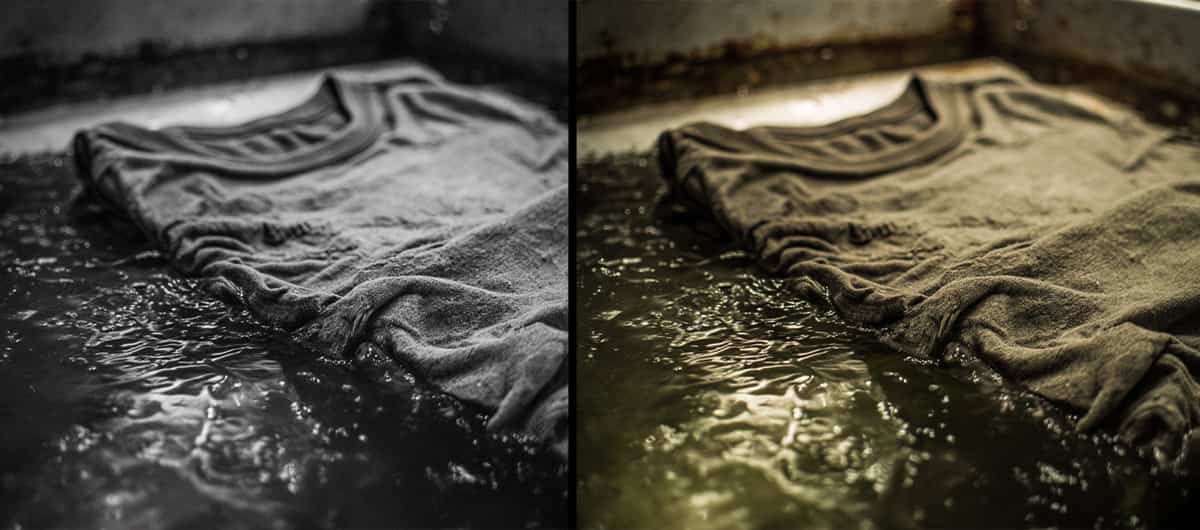

- 5.3 Chemical Wash:
Uses strong alkaline additives like sodium hydroxide (NaOH) and sodium metasilicate (NaSiO₃) at 60°–80°C for 30–60 minutes. This creates a faded, soft finish with fuller hand feel. Combined with stone washing, it enhances a distressed, vintage look. Ideal for denim and T-shirts that emphasize worn-in softness and character.
6.Sustainable Washing Solutions for Vintage Apparel
- 01
-
Ozone Wash
Utilizes ozone gas to fade fabric with minimal water and chemicals, creating natural vintage effects in an eco-friendly manner.
- 02
-
Laser Distressing
Laser technology is used to create patterns like whiskers and frays on the fabric, requiring no water or chemicals, making it one of the most sustainable techniques.
- 03
-
Bubble Wash
Nano bubbles are injected into the water to enhance washing, reduce water and detergent usage, and improve efficiency.
- 04
-
Eco Stone Wash
Ceramic or resin balls replace pumice stones, reducing pollution and improving consistency, while being reusable and more eco-friendly.
- 05
-
Waterless Bleaching
A dry technology process that changes denim color without using water, ideal for achieving light-colored, aged effects.
- 06
-
Water Recycling System
A closed-loop water system purifies and recycles wastewater, reducing fresh water consumption, operating costs, and emissions.
- 07
-
Eco-friendly Chemicals
Biodegradable detergents, oxidants, and softeners, like hydrogen peroxide, are used to minimize environmental impact and protect worker health.
- 08
-
8. Energy Efficiency
Low-temperature washing systems, high-efficiency equipment, and solar-assisted technologies are employed to reduce energy consumption and carbon footprint.
7. Conclusion
7.1 The Art and Science of Vintage Wash
Vintage washing blends both art
and science. Artistically, it reflects the creativity of designers, expressing different
styles through various wash effects. Scientifically, it involves precise control over
textile engineering, chemistry, and machinery, requiring strict quality
management. This combination of creativity
and technology transforms a washed garment into not just apparel, but a unique
piece of craftsmanship.
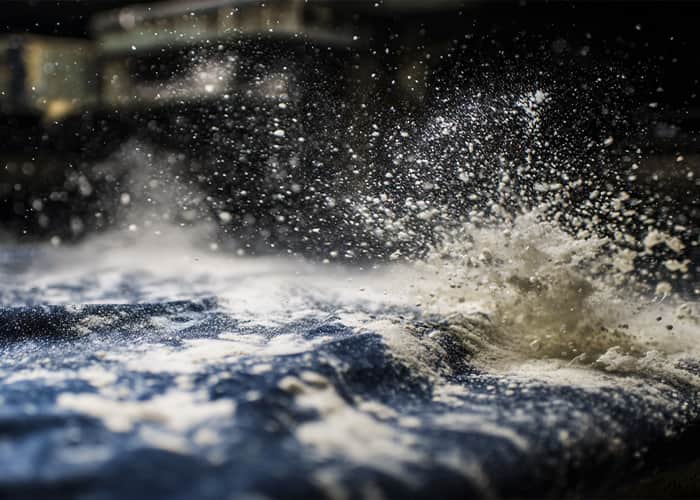
7.2 Future Trends in Vintage Wash Industry
Looking forward, key
trends in the vintage washing industry include:
1. Sustainability
Eco-friendly technologies like water recycling, green chemicals, and energy-efficient equipment will continue to lead the way, driven by the growing demand for sustainable products.
2. Digitalization & Smart Technology
3D design, digital sampling, and automated control will enhance the precision, efficiency, and creativity in vintage washing, while AI and data analysis will optimize processes.
3. Customization & Personalization
With consumers seeking unique styles, the focus will shift towards small-batch production and custom wash finishes, giving brands an edge in offering personalized products.
4. Globalization & Localization
As the production of vintage-washed apparel grows globally, regional styles and cultural influences will continue to merge, creating a richer, more diverse vintage clothing culture.
Work with us to create high-quality vintage-washed apparel
We are a factory specializing in the production of high-quality vintage-washed T-shirts, sweatshirts, and jackets, with extensive experience in washing technology and advanced production equipment. Whether you are an American designer, a growing brand, or an established brand, we can provide you with professional vintage-wash apparel production solutions.
Frequently Asked Questions
Please see below
for frequently asked questions, if you have other questions,
please contact us directly, we will answer for you at any
time.
-
What do I need to prepare to start?To start your order with WASHTIK, your trusted vintage washed tops manufacturer, please prepare the following materials:
1.Branding Files:
Your logos in vector file formats such as .AI, .PSD, .EPS, .SVG, or .PDF.2.Designs:
Tech packs detailing your designs. If you don’t have tech packs, you can provide at least three high-resolution reference images from different views or sketches. Alternatively, share your design inspirations with us, and we can provide free mock up for your confirmation.3.Artwork Files:
Files for print, embroidery, notions, and packaging must be in vector file format with dimensions specified. We can also offer guidance on appropriate sizes if needed.4.Sizing Information:
A size chart with garment measurements for each design. You may also choose from our size options, as we have selections available from famous brands. Please note that body measurements cannot be used.Having these materials ready will help ensure a smooth and efficient production process. If you have any questions or need assistance with your preparations, feel free to contact our team. -
What's the MOQ for your vintage washed tops manufacturing?The minimum order quantity (MOQ) for vintage washed tops manufacturing at WASHTIK starts from 30 pieces across all designs for each order. Please note that for custom hardware, fabrics, trims, notions, dyeing, printing, embroidery, bags, and leather patches, different MOQs may apply.For specific details regarding MOQs for custom items or to discuss your order requirements, please kindly inquire with our team, and we will be happy to assist you.
-
How long will it take to receive a response regarding a quote or other inquiries?At WASHTIK, we prioritize timely communication with our clients. You can expect to receive a response regarding your quote or other inquiries typically within 10 hours. Our dedicated customer service team is committed to addressing your questions and providing the information you need to move forward with your order.If you have urgent inquiries, please feel free to indicate the urgency in your message, and we will do our best to accommodate your request. Thank you for choosing WASHTIK as your trusted vintage washed tops manufacturer.
-
Can I order a sample before ordering?
"Yes, you can order a sample before placing a production order. Pre-production samples are created exactly as they will be in large-scale production to ensure all details are confirmed. We require payment for the sample and shipping costs. However, if you place a direct production order, we can accept a deposit instead of the sample fee, though you will still need to cover the shipping costs for the sample. This process ensures you are satisfied with the design and quality before committing to a larger order.
We offer both prototyping and sample production services to meet your needs. Our prototyping service allows you to see and feel the exact product, ensuring every detail meets your specifications. This way, you can be confident in the final production run. Please note that while we cover the production costs for direct orders, sample shipping costs are the responsibility of the customer. This approach ensures transparency and trust, providing you with the highest level of service and quality." -
Payment & Business Terms
Q30 What payment methods do you accept?
A: We accept T/T (bank transfer) and L/c for larger orders. All payment channels are secure and traceable.Q31 What are your standard payment terms?
A: for new clients, we typically require a 40% deposit to begin production, with the balance payable before shipment.Q32 Can the deposit ratio be adjusted forlong-term cooperative clients?
A:Yes,for our valued long-term patners, we can fexibly adjust the deposit ratio based on order volume, cooperation history, and credit evaluation.Q33 Can lpay in different currencies (USD, EUR, etc.)?
A: Yes. We support payments in USD, EUR, AUD, and more to accommodate international clients.Q34 What is your refund or cancellation policy?
A: Once production begins, orders are non-refundable. For cancellations before production,fees may apply depending on the stage of development. -
Do you work with startups or only established brands?Partnering with diverse businesses - from nimble startups and solopreneurs to established multinational corporations. Our tailored production solutions adapt seamlessly to your project scope and financial parameters, ensuring optimal ROI across all scales.
-
How do I contact you?You can contact us anytime on whatsapp or by email at [email protected].
-
What payment methods are accepted?Payments:1.Wire Transfer From All Countries2.Pingpong Payment (Credit Card Accept)3.Alibaba Trade Assurance. Click for payment information.
-
How Does WASHTIK Process Digital Printing on Vintage Washed Tops?As a professional vintage washed tops manufacturer, WASHTIK employs advanced digital printing technology through a systematic process:
Key Production Steps:
1.Pre-treatment
Professional fabric preparationSurface treatment for optimal ink absorption2.Digital Printing
High-precision printing equipmentWater-based eco-friendly inksDirect design application3.Heat Setting
Professional heat curingColor fixation processDurability enhancement4.Quality Assurance
Print quality verificationWash test confirmationColor consistency check -
Can Embroidery Be Done on the Printed Part of the Vintage Washed Tops?Yes, WASHTIK can apply embroidery on printed areas of vintage washed tops, but specific technical considerations apply:
Technical Considerations:
Print type must be assessed for embroidery compatibilityDesign placement requires professional planningSequence: printing is completed before embroideryQuality control measures ensure durabilityRecommendations: We recommend consulting with our technical team during the design phase for optimal results. -
What Printing Method Do You Use for All-Over Prints?Our printing methods are specifically selected based on fabric type to ensure optimal results:
Fabric-Specific Solutions:
Cotton & Cotton-Poly Blends: Digital or screen printingRayon/Tencel/Modal: Digital printingPolyester: Sublimation printing -
Do You Use a White Under Base for Printing?Screen printing: No white under base is used. Digital printing: Yes, white under base is applied for light-colored designs on dark fabrics to ensure color vibrancy.
Start cooperation
- Quick Quotation
Contact Person
- Name:
- Leo Kim
- Tel:
-
+86-15102711858
- Email:
- [email protected]
- WhatsApp:
- https://wa.me/8615102711858
- Address:
- Building 3, Hongyun Jiuchang, No. 15 Road, Dongxihu New City, Dongxihu District, Wuhan, China
subscription

